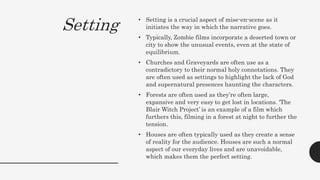Conventions
- 2. Lack of God • The Narrative of many Horror film has a focus around a devil-like creature/ spirit which haunts and harms the central characters. Many Props such as bibles and crucifix's are used as a defense from these supernatural forces. However, it is also a typical convention of horror films for these typical religious icons being used to highlight a lack of God and to symbolize the devil.
- 3. Colour • Typically, in horror, all colours and lighting are very low-key to create a tense and scary atmosphere. Many of the colours frequently used have very important connotations and symbolism. • Green is envy, environmental or budgetary • red is bloody, passionate or speedy • yellow is sickness, insanity and sunny • Black and are potentially two of the most important and symbolic colours as they’re so striking and change the mood that the director is trying to portray in a specific setting. • Typically, white is used to connote purity, innocence, and even infancy, especially in regards to women. However, many films use this typical representation of white to fool the audience, and use the colour white to create a false sense of security for the audience.
- 4. Shot Types • Birds eye and high angle shots: These shots are used to portray a person or object as powerless and defeated. These are normally used to show the power difference between a weaker and stronger powers. • Close up shots: These are used to show the emotion of characters. This helps the audience to feel as though they’re building a connection with the characters as they’re able to relate to the emotions of characters. • Tilted shots: These can be used to create tension as the setting is ‘off’, the audience can infer that something unnatural will soon happen. • Establishing and Extreme long shots: These are used to show the audience the key settings in the narrative. These can be crucial to show how deserted a town or city is. • Low angle: These are used emphasize the power held by a villain and to highlight how scary and intimidating they are • Hand-held shots: these are used to create a sense of reality, and in tern, creating a scarier atmosphere as the audience view these occurrences as events that could also happen to them.
- 5. Children • Children who have a supernatural or sociopathic understanding of the rules of normality deliberately disregard them are typically shown in horror. Children’s innocence and virtuous qualities are generically subverted in horror as we expect children to be represented as non-threatening entities. Horror is able to force doubt into our natural assumptions, which is a staple of effective horror. • Film Theorist Mary Jackson identifies the fear inflicted by children in She talks about the sub-genre 'Children as Horror', and identifies our fear of these 'Evil Children' as the representation of our terror of failing the younger generation: ‘Not surprisingly, in the run of child-as- monster films, frequently the real point is not the evil of children, often the victims of demonic possession themselves, but rather the ineffectiveness of the family, church, and state – America’s most highly valued institutions – to guard themselves against deception and impending destruction.’
- 6. Setting • Setting is a crucial aspect of mise-en-scene as it initiates the way in which the narrative goes. • Typically, Zombie films incorporate a deserted town or city to show the unusual events, even at the state of equilibrium. • Churches and Graveyards are often use as a contradictory to their normal holy connotations. They are often used as settings to highlight the lack of God and supernatural presences haunting the characters. • Forests are often used as they’re often large, expansive and very easy to get lost in locations. ‘The Blair Witch Project’ is an example of a film which furthers this, filming in a forest at night to further the tension. • Houses are often typically used as they create a sense of reality for the audience. Houses are such a normal aspect of our everyday lives and are unavoidable, which makes them the perfect setting.





